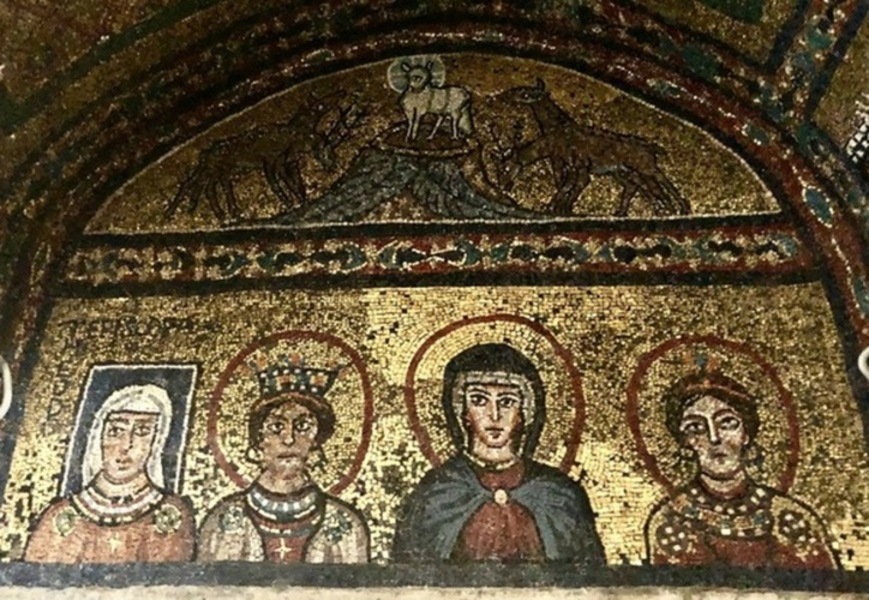
Historic Siblings Who Partnered in Ministry
During my flight to Italy for a seminary summer course, I looked again at a photocopy of an ancient mosaic of four women. In my pre-course research on the history of women in ministry, I happened upon this photograph of a ninth-century mosaic adorning a wall of an ancient basilica (church). While in Rome, I hoped to find the Basilica of Santa Prassede and to learn these women’s stories, two of whom were siblings who partnered in ministry.
A God-Wink
One steamy afternoon while the rest of our group toured the Colosseum in Rome, my professor Sandra Glahn joined me to search for the Basilica of Santa Prassede. Though Rome’s city center encompasses approximately 500 square miles, I remained cautiously optimistic. Activating my phone GPS, Dr. Glahn and I stepped out of the Sisters of Saint Elizabeth monastery, our lodging place while in the city, and began our search.
We walked down to the street corner and were directed to turn right onto the adjoining side street. Less than one block later we were astounded to arrive at the entrance to the sought-after Basilica. The church of Santa Prassede is located about a half mile from the renowned St. Mary Maggiore, a basilica built in honor of the Virgin Mary and perched atop Rome’s Esquiline hill. The shock and delight of discovering “my” basilica just around the corner from our lodging remains a memorable God-wink.
A Mosaic in the Zeno Chapel
We entered the basilica and discovered more than we’d hoped for. The Basilica of Santa Prassede contains “the most extensive Christian Roman mosaic program prior to 1200,” aside from St. Maria Maggiore’s mosaics. In the tiny chapel just off the east aisle, the Zeno Chapel, we located the mosaic in my photo. We learned that the four women featured were Theodora Episcopa (the pope’s mother for whom the chapel was built), the Virgin Mary, and on either side of Mary, two sisters, Prassedes and Pudentiana.

Sacred Siblings
A stunning mosaic scene at the front of the basilica features seven figures: Pope Paschal I, Prassedes, Paul, Christ, Peter, Pudentiana, and a deacon. Paul’s left arm encircles Prassedes while Peter’s right arm encircles Pudentiana, illustrating a siblings-in-Christ affection and affirmation. Additional mosaics in the basilica echo a sacred sibling theme.
Prassedes and Pudentiana
According to ancient tradition, Prassede and Pudentiana were born into a Roman senatorial family. Their grandfather Quintus Cornelius Pudens extended hospitality to and was baptized by, the apostle Peter. Their father Pudens (Junior) was said to have been brought to faith by the apostle Paul. Excavations under the basilica have uncovered a two-story private Roman house. Likely it was the Pudens family home and the site of an early Christian house church. Paul’s second letter to Timothy extends greetings from individuals in the Roman church, “Greetings to you from Eubulus, Pudens, Linus, Claudia, and all the brothers and sisters” (2 Tim 4:21).
After Pudens’ (Jr) death, his daughters devoted themselves to serving the Lord. They deployed their considerable resources to ministry and care of the poor. Living during the “age of the martyrs” in Rome, Prassedes hid many persecuted Christians, nourishing them “with earthly food and the word of God.” In one account, after twenty-two Christians were found and beheaded by order of the emperor, a grieving Prassedes buried the bodies in the Catacomb of Priscilla, one of the oldest Christian cemeteries. Since the eighth century, the Monday station during Rome’s Holy Week is the Basilica of Santa Prassede.[1]
The Basilica of Santa Pudentiana
Upon further investigation, I visited the sister church, the Basilica of Santa Pudentiana. Located a few blocks down the hill from St. Mary Maggiore, a large painting in the foyer depicts the sisters washing the bodies of Christian martyrs. After their deaths, each sister was honored for their exemplary service with a Saint’s Day.
Prassedes and Pudentiana’s story reminds me of two other sets of devoted siblings who partnered in ministry.
Scholastica and Benedict
In the mid-500s, Benedict of Nursia established his first monastery for men in Italy. Under the rule of Benedict, additional Benedictine monasteries were also formed. Scholastica, Benedict’s twin sister, dedicated herself to the Lord at an early age. With her brother’s tutelage and support, she founded the first convent for women. Under Scholastica’s leadership as abbess, Benedictine convents formed across the continent. A 2018 survey counted approximately 7,500 monks and 13,000 nuns and sisters in the Benedictine order.[2]
Clare and Francis of Assisi
At a young age, Clare of Assisi took a vow of celibacy. At age eighteen, she heard Francis, founder of the Franciscans, preach. Francis met with Clare to provide her with spiritual guidance and brotherly support. Clare dedicated herself to a life of poverty, charity, and prayer. Frances took her to San Damiano, a small church in Assisi, where she lived and ministered until her death. Clare founded the Poor Clares, a monastic order for women. Organized under the rule of St. Clare, convents formed across Europe.[3]
Sibling Ministry Partnering in Scripture
Fruitful ministry often involves ministry partnering. Whether blood siblings or siblings-in-Christ, ministry partnership examples in scripture include:
- Miriam along with her brothers Moses and Aaron led the Israelites (Ex 15:20).
- Deborah and Barak battled their foe together and the Israelites enjoyed four decades of peace (Judg 4:4-23).
- Abigail and David’s pact averted a slaughter (1 Sam 25).
- Esther and Mordecai worked together to ensure the Jewish nation escaped annihilation (Esther 4–5).
- Phoebe delivered and interpreted Paul’s letter of Romans to the Roman house churches (Rom 16:1–2).
- Euodia and Syntyche “contended at my [Paul’s] side in the cause of the gospel” as “co-workers”(Phil 4:2–3).
Conclusion
The sibling stories above illustrate this truth, “What should you do then, brothers and sisters? When you come together, each one has a song, has a lesson, has a revelation, has a tongue, has an interpretation. Let all these things be done for the strengthening of the church (1 Cor 14:26 NET).” Treating each other as brothers and sisters—as siblings—helps us value one another’s voices, empower one another’s gifts, and accomplish fruitful ministry. Sacred siblings partnering together strengthens the mission.
- Mary M. Schaefer, Women in Pastoral Office: The Story of Santa Prassede, Rome, (New York, NY: Oxford University Press, 2013), 10–24, 44. ↑
- Ruth A. Tucker and Walter Liefeld, Daughters of the Church: Women and Ministry from New Testament Times to the Present, Grand Rapids, MI: Zondervan, 1987), 133–4; Richard Oliver, ed. “A Brief History of the Benedictine Order,” https://osb.org/our-roots/a-brief-history-of-the-benedictine-order/; Margaux Salcedo, “The Crozier of St. Scholastica,” Feb 9, 2021. https://dominusest.ph/post/the-crozier-of-st-scholastica ↑
- Katharina M. Wilson, “Christian Women Writers of the Medieval World,” Christian History, Issue 30, 2017, 23. ↑




